PROFILE: MICHEL JAZY
b. 1936
Michel Jazy was one of the great runners of the 1960s and one of the most elegant. He possessed a lethal kick that at times looked unanswerable. His elegance and competitive success made him a celebrity in France. His best distance was 3,000 or 2 miles; for winning Olympic gold he was not quite fast enough for 1,500 and not quite strong enough for 5,000. Thus he was unable to beat Herb Elliott over 1,500 in Rome and faded to fourth in the last meters of the Tokyo 5,000. Nevertheless, he won two European golds and one silver. Perhaps more significantly he set nine WRs and 17 European records.
Born in 1936 into a coal-mining family from Poland, Michel Jazy was brought up by his grandparents after his parents separated. At 14 he rejoined his mother in Paris and was apprenticed in the printing industry. After starting in soccer, he showed ability as a runner and soon won a national race. He then was coached by René Frassinelli, who with Charles Poulenard, the coach of the great Ladoumègue, quickly saw Jazy’s potential. In 1956 he made French team v. Belgium and was selected for Melbourne Olympics.
First Olympics
In Melbourne, despite equaling his PB, he was eliminated in the heats, finishing seventh in 3:49.6. The likes of Richtzenhain, Jungwirth, Boyd, Halberg and Rozsavolgyi in his heat was too much for the inexperienced runner. Still, he had a lucky break during the Olympics: he was chosen to share a room with the great Alain Mimoun. (Mimoun, of course, won the Olympic Marathon.) This experience was life changing for Jazy: “I came to realize down there in Melbourne what glory was and what sacrifices were necessary in the years ahead to obtain it. Alain Mimoun opened my eyes to what I needed to do. I became hungry; I had got the message.” (Mes victoires, mes défaites, ma vie, p. 96, my translation)
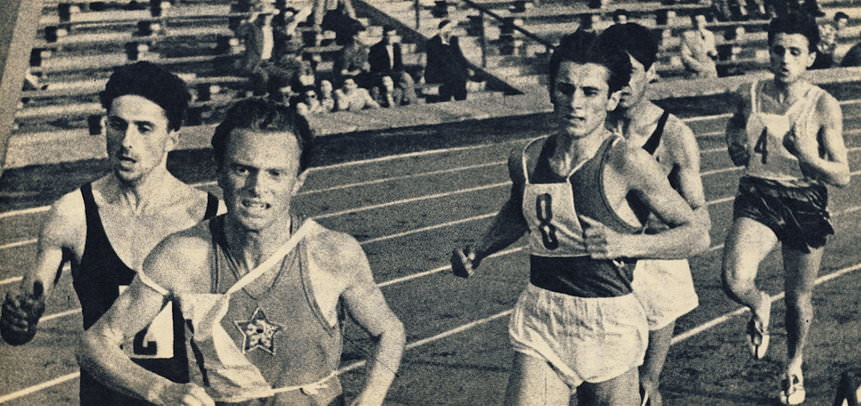 |
| 1957: Jazy (4), trailing a field led by Jungwirth, sets a French 1,500 record (3:44) for the first of eight times. |
Moving Up
There was a long way to go. First of all, he had to do his military stint in the French air force. His running career was not interrupted however. In 1957, the year of his marriage, he ran 3:43.6 for 1,500, 5:15 for 2,000 and 8:02.4 for 3,000, all French National records. But he disappointed in the 1958 Euros, finishing tenth in the final, after being the slowest qualifier: “I fell to earth with a thud. I had never known such humiliation. I was ashamed.” (Mes victoires, p. 105) Soon after the Euros, Jazy finished his military duties. At this point, Jazy had another lucky break. L’Equipe, the French sports daily, took him on as an employee with the specific aim of helping him reach the top of the track world. (Note: Athletes were still supposed to be amateurs at this time, so talented athletes often were given soft or nominal jobs with an income.) On the initiative of Gaston Meyer, editor-in-chief at the paper, everything was set up to enable Jazy to succeed on the track, specifically to place in the top six in the Rome 1,500 and to win the 1962 European 1,500.
Training Issues
At first, there was little progress. In 1959 he suffered a mysterious foot injury and only improved his 1958 1,500 PB of 3:42.2 by 0.1 of a second. And he was beaten in the French Championships by his rival Michel Bernard. So although he ranked 10th in the world for 800 (1:47.9) and sixth for 1,500 (3:42.1), Jazy had some doubts about his progress. And he recorded such doubts in his book, questioning whether he was training correctly.
His mind became settled after a visit to German coach Waldemar Gerschler in Germany. Gerschler’s scientific testing found he was in great shape and possessed exceptional recuperative powers. But he and Gerschler didn’t agree on training methods. Gerschler dismissed Jazy’s “natural training” approach, insisting on timed interval training on the track. Jazy found the German’s method boring and soul destroying: “The next year, instead of breathing madly into a respirator and pedaling on my back to make a needle vibrate in a dial, I decided to travel in freedom to Gosta Olander at Valadalen.” (Mes victories, p. 118, my translation) Jazy rightly concluded that he was an inspirational runner who depended on enjoying his training. Thus his decision to train in the forests rather than on the 400-meter track brought the best results for him.
The hard training over the next year, including some valuable time with Gosta Olander at the remote Swedish retreat at Valadalen, began to pay off. And despite a defeat in England over 800, Jazy went to Rome believing he could run at least 3:40.
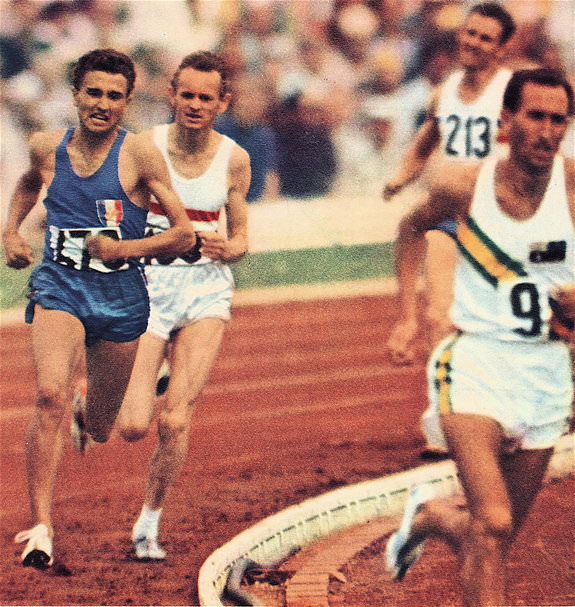 |
| Rome Olympics. Jazy (in blue), trailing Elliott, has moved past Rozsavolgyi going into the last bend. |
Breakthrough
The Rome 1,500 was a dream come true for him. General expectations saw him making he final, but not much more. Michel Bernard, his team-mate and rival, set the pace “ like a demon,” according to Jazy. He felt “marvelously lucid” and managed to avoid getting boxed in. So when Elliott made his early bid for the tape with 400 to go, he was able to respond with Rozsavolgyi. And when Rozsavolgyi started to fade along the back straight, he was able to move into second. It was then a matter of holding on as Elliott’s lead was too great. He finished a surprising second in the wonderful time of 3:38.4. Suddenly he was an international star.
After Rome, Jazy enjoyed a break from his training regime. And it took him a while to return from the dizzy heights of his Rome success. He didn’t rank high in the 1961 world rankings, though he did set national records for 1,000 (2:20.1) and 2,000 (5:10 .2). Then over the 1961-2 winter he trained harder than ever. This paid off in 1962 with a slate of records, notably the 2,000 world record (5:01.6) and the 3,000 world record (7:49.2). As well, he set national records in 800 (1:47.1), 1,500 (3:38.3), and One Mile (3:59.8).
Euro Champion
The icing on the cake was a classy win in the 1962 European 1,500. He ran the final with new-found confidence, having just run a 3:39.9 in July. Jazy exchanged the lead with Witold Baran of Poland for the first two laps (59.8, 2:01.4). Then he let the Pole do all the work in the third lap (3:01.4). Jazy waited until the back straight to make his move. His last 200 in 25.9 gave him a clear 1.1 second advantage at the tape. He wrote later that he won this race “without the least difficulty.”
After this success, Jazy made a calculated attack on Jungwirth’s European 1,500 record of 3:38.1. Pacemakers took him through the first 800 in 1:57, but then he was on his own. He needed at least a 57.5 last lap, but fell agonizingly short with a 57.8 and a 3:38.3 clocking. Still, 1962 was a banner year for Michel Jazy: no one beat him to the tape that year.
By this time Jazy had become a major celebrity in France, almost on a par with Brigitte Bardot and Johnny Hallyday. Now in the national limelight, Jazy was able to quit his job as a typographer with L’Equipe and go to work for Perrier in a public-relations role. His training was now focused on Tokyo, almost two years ahead. So not surprisingly the 1963 season was relatively quiet. Jazy again ranked #1 in the world for 1,500 with 3:37.8, a new European record. But his 1963 season was foreshortened by a spiking accident during training in Sweden and a subsequent bad reaction to a tetanus shot. Still, his season was encouraging. Significantly he ranked high in the 5,000 for the first time—11th with 13:50.2. He also set a 2 Miles world record with 8:29.6.
 |
| Tokyo: About 250 to go, Jazy leads Norpoth, Schul,Dutov, Delinger, Baillie and Keino. |
Tokyo Ahead
Jazy was planning to run both the 1,500 and 5,000 in Tokyo. In truth, Jazy was unfortunate that his best distance, 3,000 or 2 Miles, was not an Olympic event. His chances looked good over 1,500, but Snell was a great threat. The 5,000 looked much more open as Halberg and Bolotnikov, the two best runners over this distance, were nearing the end of their careers. Changes to the Olympic schedule ultimately did not allow him to run both events. So Jazy opted for the 5,000. Perhaps his decision was made because of the domination of Peter Snell over 1,500. Nevertheless, it would have been interesting to see if he could have matched Snell’s amazing finish in the Tokyo 1,500.
The 1964 season started well with an 8:05 3,000 and a brisk 3:39.8 5,000. Then there was a setback that underlined his need for more endurance strength. In July he raced Ron Clarke over 5,000 and was unable to hold on to the Australian. His broken confidence was somewhat restored with a 13:46.8 and a 3:57.9 Mile just before the Games. Jazy clearly had the speed, but did he have enough strength to win the Olympic 5,000?
Tokyo 5,000 Final
He looked immaculate in winning his heat in 13:55.4. The final, two days later, was run in a downpour on a sodden track. The start was slow (68,8 and 2:18.5), probably a good thing for Jazy--but not for Clarke, who injected a 64.7 lap and then slowed to 67.2 and 68.5. For the next lap Clarke really went hard with a 62.5. Jazy was the only one to go with him. But then Clarke slowed to a 70.6. The field was back with them, and some precious energy had been wasted.
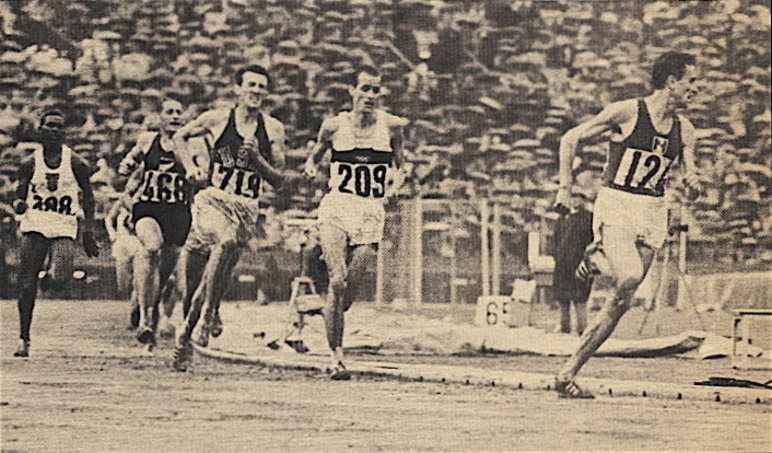 |
| Tokyo :Jazy leads Norpoth (209) and Schul with 100 to go. |
There were still nine runners in the lead group with 600 to go. As Clarke neared the bell, Bill Dellinger of the USA surged by. Jazy went with him and took the lead halfway into the bend. As he entered the back straight, he already had an 8m lead over the field. His acceleration had been stunning, but it had perhaps been too drastic. As the pack chased him down the back straight, Bob Schul emerged and closed in on Jazy. The American finally caught him 70m out and surged to victory. Then Norpoth caught him and on the line Dellinger took the bronze from the fading Frenchman. Jazy clearly had the speed to win the race, but he had gone too early and put too much demand on his strength. Perhaps his insecurity over his limited experience in the 5,000 made him attack early. It was a cruel defeat for him. As David Cocksedge wrote, “Jazy was distraught and France went into mourning.” (“Michel Jazy: French Middle-Distance Hero of the Sixties.” (BMC News, Spring 1984, p. 10)
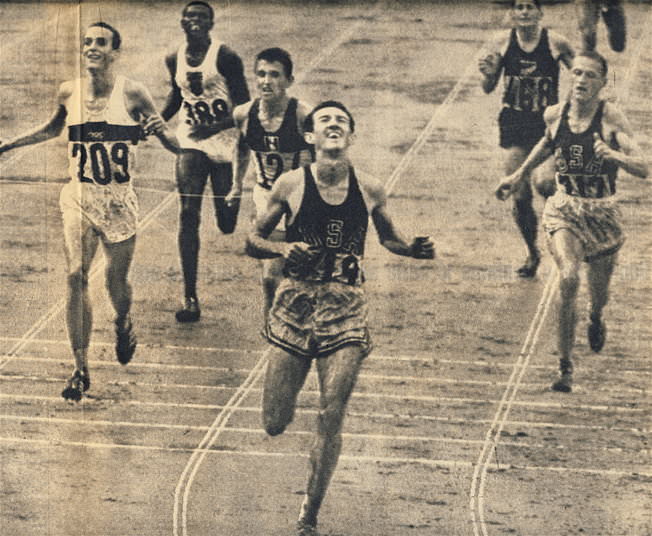 |
| Tokyo: Schul wins from (left to right) Norpoth (2nd), Keino (5th), Jazy (4th), Baillie (6th) and Dellinger (3rd). |
Bouncing Back
Retirement was a consideration after this debacle. Fortunately, Jazy decided to continue, perhaps moved by the more than 10,000 letters he received from fans after the Games.
As it turned out, Jazy probably wasn’t ready for the 5,000 until 1965. In that year he reduced his PB from 13:46.8 three times: 13:34.4, 13:29.0, 13:27.6. All three of these times were European records, Kuts having previously held the European record at 13:35. Jazy certainly bounced back from his Tokyo defeat. He had a wonderful June, breaking four world records: One Mile in 3:53.6; 3,000 in 7:49; 2 Miles in 8:22.6 and the 4x1,500 Relay. After Ron Clarke had helped him break the 2-Mile and 3,000 world records in the same race, Jazy broke his competitive schedule to run against the Australian in the World Games in Helsinki over 5,000. It was a chance to see if he really was the best 5,000 runner in the world.
This race had a marvelous field: Jazy, Keino, Clarke, Schul, Wiggs, Mills, and Haase. Following a pre-race agreement, Clarke and Jazy kept the early pace so fast (2:41, 5:24) that Schul was dropped after five laps. At 3,000 (8:05) only Clarke, Keino and Jazy were in the lead group. After eight laps Clarke tried in vain to break his two opponents. When he realized that he couldn’t do this, he eased up and decided to wait till he last 500. But his acceleration at this point was again easily matched by Jazy and Keino. Clarke led at the bell (12:31), and soon after Keino sprinted by. Clarke was dropped, but Jazy easily slipped into the Kenyan’s wake. Jazy made his effort on entering the last bend. With a last 200 in 26.6, he held on to win by 0.6 of a second with a new European record of 13:27.6. This was a fitting climax to his wonderful 1965 season.
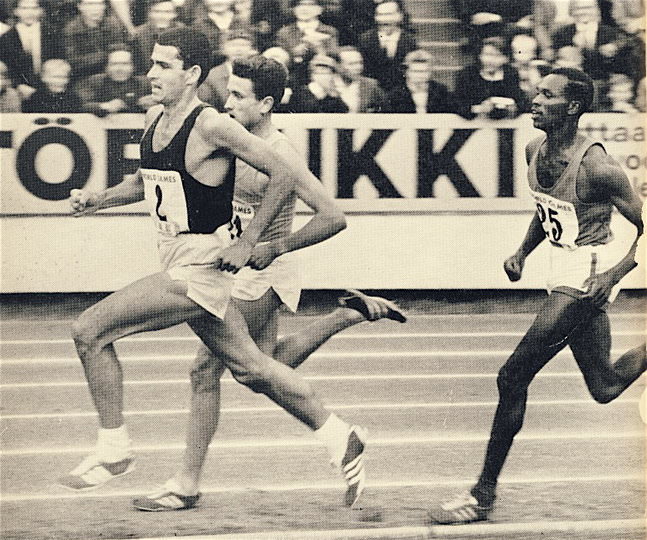 |
| Helsinki World Games: Jazy, right on Ron Clarke's shoulder, waits to kick for home. Keino runs third. |
Nearing the End
Now 29, Jazy decided that 1966 would be his last season. Some of his supporters wanted him to keeping going until the 1968 Olympics, but Jazy wasn’t interested. Sports Illustrated quoted him as calling the Mexico Olympics a “scandale” and saying that he would rather retire than run at an “unfair altitude.” (SI, July 4, 1966) Naturally his season was focused on the European Championships in Budapest, where he planned a 1,500/5,000 double. But he also wanted to break Elliott’s 1,500 record as well. The season started well with a steady 5,000 in 13:38.2. Next he set new European 1,500 record of 3:36.3. Four days later he ran a 54.7 last lap to win an international 3,000 in 7:51.8. A week later another 1,500 attempt resulted in exactly the same 3:36.3 time.
In the Euros, Jazy had to contend with a tactical 1,500. The bell was reached in a slow 2:49. On the backstretch, he was surprised by 800-specialist Bodo Tummler, who led into the last bend ahead of Norpoth. Jazy caught Norpoth 40m out, but Tummler hit the tape first 3:41.9 to Jazy’s 3:42.2. It had taken a 52.2 last lap to beat Jazy.
Norpoth was again competing against Jazy in the 5,000. He made his bid for home with just under 1K to go. It was a vain attempt to dull Jazy’s finishing kick. The duo were out on their own. Jazy waited until the last 100 to blaze by for a clear victory in 13:42.8. He had run the last 800 in 1:57.4.
There were a few more races to be run. Jazy was winning them all. And finally in October, he successfully attacked Norpoth’s 2,000 WR of 4:57.8 with a 4:56.2. This was his seventh individual WR. All of them were between One Mile and Two Miles, including 2,000 and 3,000. Undoubtedly his best distance was between 2,000 and 3,000. Sadly, there was no Olympic race within this range. So Jazy had to be satisfied with an Olympic silver and two European golds and one silver. His immaculate running style and often unanswerable finishing kick were a sight to behold. Today, films of his races are still inspiring. 
4 Comments